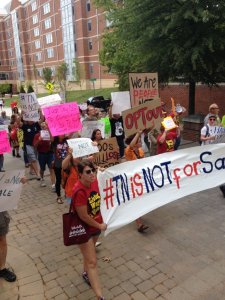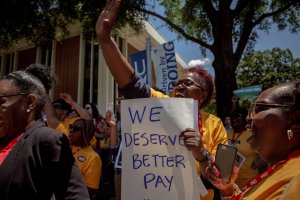This is the first in a series of essays on “Higher Ed Wall-to Wall in Tennessee,” which will continue for the rest of this week. This series of posts highlights voices and union-led campaigns on higher-ed campuses across Tennessee. We hope to offer both a picture of the challenges that we face and perhaps some organizing solutions, particularly to other higher education employees in right-to-work states, to help navigate the shifting academic terrain that we are experiencing in the face of COVID-19. The series of posts was facilitated by Andrea Ringer.
“Though workers needed unionization more than ever, an atmosphere of fear seemed to have settled over industrial America…”–Peter Rachleff, “Organizing Wall-to-Wall”[1]
Workers in the United States are facing a crisis as significant as the last major capitalist crisis, and perhaps it promises some new directions. For the first time since the depths of the Great Depression, non-farm labor unemployment reached 15% and will likely remain above 10% for the foreseeable future. This economic collapse has not affected all people equally. Even as unemployment continues to rise, so too do the major stock indexes in New York and Chicago, as profits for those at the top of the current system grow larger and larger (best evidenced by reports that Jeff Bezos, the founder and owner of Amazon, may soon become the world’s first trillionaire). The United States is the wealthiest country in human history by any measurement, and yet basic institutions are being gutted all around us. This ranges from the pending collapse of the U.S. Post Office, which congressional Republicans have effectively committed to privatizing, to the systematic undermining of public higher education over the past two decades.
In this series of posts, and in light of the ongoing crises caused by COVID-19, members of the United Campus Workers (UCW) of Tennessee address the current threats that we, as workers, are facing. During the twentieth century, organizing has been forced to shift to meet workers’ needs in different circumstances, from the Depression to the energy crises of the 1970s to privatization and the withdrawal of state funding in the 1990s and 2000s. In the US South, historically hostile to organized labor, UCW (an affiliate of the Communications Workers of America) has pursued a wall-to-wall model that blends longer traditions of faculty and social unionism, and that consciously makes space for all university employees. These posts offer working people in Tennessee higher education–graduate workers, contingent faculty, and those deemed “essential”–an opportunity to voice their concerns about the problems they face and the possible solutions they see.
History of Higher Education Unions
Faculty unions emerged in the first decades of the twentieth century.[2] Their initial concerns ranged from improving salaries to more power in university decision-making and oversight. Although there are currently hundreds of thousands of instructors represented by unions on campuses across the U.S., faculty unions still face the uphill battle of convincing faculty, and especially tenure-stream faculty, to recognize their interests as workers. This required (and continues to require) a re-imagining of the university space as a shop floor, together with a recognition of the labor done by myriad employees–from faculty to support staff to maintenance workers–as “producing” the product of the university: an environment dedicated to particular forms and modes of learning. Going back to the formation of one of the first unions at the University of Illinois in the 1910s and 1920s, resolving the tension between so-called “brain workers” and “hand workers” was one of the main goals of the new organization.[3] While some faculty unions, mainly in states that have historically favored organized labor, have been able to bargain collectively, many sought alternative avenues for exerting pressure on the administration and, occasionally, on state authorities.
Social Unionism/Wall-to-Wall Organizing
Indeed, from the 1930s through the 1960s, many who joined faculty unions did so as part of a broader idea about social unionism–labor organizing that did not organize workers into discrete bargaining units but instead sought to construct solidarity across all levels of a workspace. Over the second half of the twentieth century, as traditional labor unions suffered a string of defeats, wall-to-wall organizing emerged as a way for workplaces with an incredible diversity of labor to organize for change. Under this system, anyone who draws a paycheck from the employer is eligible to join, and rather than focus on collective bargaining, the union uses coordinated campaigns and public pressure as tools for agitation and progress. The wall-to-wall approach has been applied to similar industries like technology and communications, where employees might have limited direct contact or even limited knowledge of their respective working conditions. Wall-to-wall organizers have argued against a narrow understanding of interest and for the benefit of larger systems.[4]

UCW in Tennessee
Since its founding in 2000, UCW has fought numerous campaigns on behalf of higher education and higher ed employees around the state. Its victories over the last twenty years have been multifaceted and grassroots driven. Bob Hutton detailed the union’s origin up to the #TNisNOTforSale campaign to fight outsourcing on campuses. As we have worked toward building greater faculty-staff solidarity, UCW has run campaigns both on individual campuses and at the state level. When the Charles Koch Foundation pledged a $3.5 million grant to Middle Tennessee State University, UCW teamed up with students to launch a campaign that called for transparency with the funding. They also brought Nancy MacLean to campus to discuss her research on the Koch Brothers network. At Tennessee State University, the state’s only public HBCU, the union has been instrumental in the ongoing Fair Funding campaign to recoup the $37 million owed by the state. At several campuses across Tennessee, UCW has been a committed supporter of the broader “Fight for $15” effort to ensure that all workers earn a living wage for their labor. During the current COVID-19 crisis, our wall-to-wall organizing model has helped UCW fight for equitable working conditions for all campus employees.
Series Overview
This series of posts highlights voices and union-led campaigns on higher-ed campuses across Tennessee. We hope to offer both a picture of the challenges that we face and perhaps some organizing solutions, particularly to other higher education employees in right-to-work states, to help navigate the shifting academic terrain that we are experiencing in the face of COVID-19. Like the faculty unions that formed in academia more than 100 years ago, the UCW campaigns in Tennessee move well beyond bread-and-butter issues. The campaign victories also demonstrate the strength in wall-to-wall organizing in right-to-work states that offer workers no avenue for collective bargaining.
Graduate workers in Tennessee and around the country share similar experiences. They face low pay in cities with rising rent and no secured benefits. Our interviews with four graduate workers at a public research university in Tennessee underscore the current crises faced by some of the most vulnerable members of our union during this pandemic, while highlighting the ongoing fight for graduate worker healthcare.
We will also address the current activist climate, particularly in Memphis. Several working-class movements, like the Fight for $15, have gained ground both at the university and the city. The struggles of working parents in that fight are often left out of the conversation. In an interview with Memphis Advocates for Radical Childcare (M.A.R.C.H.) founder Phuong Nguyen, we explore the barriers to working-class protest and highlight a current statewide push for paid family leave in higher education.

For faculty, and especially non-tenure-track faculty, our current moment presents a number of difficult challenges. Already contingent, instructors and adjuncts now confront increased precarity and uncertainty, as most, employed on year-to-year contracts, have to navigate an unprecedented teaching situation, often without the benefit of clear instructions from administrators. A conversation with Thomas Richardson (pseudonym), an instructor at University of Tennessee, Chattanooga, works through some of these issues.
Perhaps the most striking contradiction laid bare by the COVID-19 crisis has been the concept of the “essential” worker–the person whose labor is deemed necessary, but who is almost always among the least compensated employees at the university. In our fourth entry to the series, we talk with maintenance workers about their experiences over the past months and what they expect for the future. Given the longstanding efforts by higher education institutions to outsource much of the maintenance and support labor to non-affiliated providers, this is an especially dangerous time for university employees in this sector.
Across these posts, we will consider both how we came to be in this situation and where we might go from here. This is a fraught moment for higher education, but also perhaps a moment of possibility. The narrative that budget cuts are necessary threatens students, faculty, and staff. To paraphrase a recent question from Marilynne Robinson, how can we constantly be told that we are the richest country ever and yet wholeheartedly believe that we are facing an unprecedented scarcity crisis?[5] Our goal here is to challenge this assumption and point to ways that we can move forward through solidarity and collective action to defend both our workplace and the broader mission of public higher education.
[1] Peter Rachleff, “Organizing ‘Wall-to-Wall’: The Independent Union of All Workers, 1933-1937,” in “We Are All Leaders”: The Alternative Unionism of the Early 1930s, ed. Staughton Lynd (Urbana, IL: University of Illinois Press, 1996).
[2] Importantly, the first faculty union appeared at Howard University, reflecting the intersection of professional and social concerns. See Timothy Cain, “Organizing the Professoriate: Faculty Unions in Historical Perspective” (March 4, 2015). Available: https://ihe.uga.edu/news/stories/2015/organizing-professoriate-faculty-unions-historical-perspective. Accessed May 31, 2020.
[3] Timothy Cain, “What Does the History of Faculty Unions Teach Us About Their Future?” Higher Ed Jobs. Available: https://www.higheredjobs.com/HigherEdCareers/interviews.cfm?ID=315. Accessed May 25, 2020.
[4] Cain, “What Does the History of Faculty Unions Teach Us About Their Future?”
[5] Marilynne Robinson, “What Kind of Country do We Want?” New York Review of Books (June 11, 2020).







